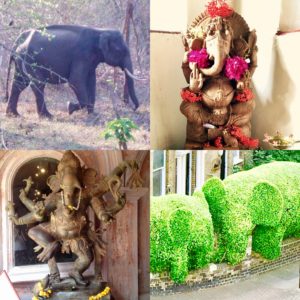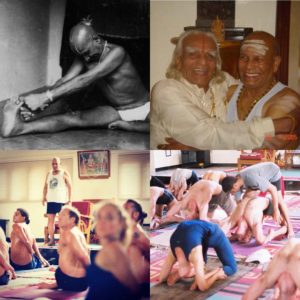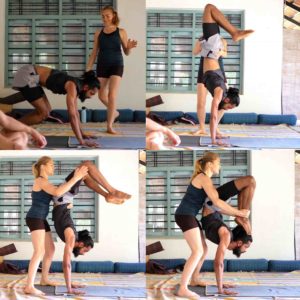Overcoming Obstacles in the Path of our Yoga Sadhana
challenges of beginning and continuing the practice
by Philippa Asher
In Hinduism, the elephant-headed god Ganesha, is the remover of obstacles and is believed to radiate qualities of wisdom, strength, grace, honour, confidence, stamina, stability, truth and patience. When seeking to overcome the numerous challenges that appear in our individual yoga sadhana (disciplined spiritual practice), many people look to the concept of Ganesha for courage. These challenges can be mental, physical, spiritual, emotional, social, practical and even superficial, but we all encounter them and the Ashtanga practice can help us to overcome them.
The key theme that weaves throughout Patanjali’s Eight Limbs (ashta meaning eight and anga meaning limbs), is echoed in the idiom ‘mind over matter’. Having the ability to control our mind, emotions, desires, speech, body and actions, can give us great strength, grace and wisdom, as well as the fortitude to change situations and to find solutions to problems that may appear in our path.
For many of us, the Ashtanga journey starts with an asana (posture, breathing and mind focusing) class. It can be overwhelming to be surrounded by able-bodied super humans, contorting their lithe limbs into unnatural shapes. I walked in and straight out of my first Ashtanga guided self-practice session in London. Had it not been for the voice behind me saying ‘Oi, where are you going?’, I’d probably have continued with led classes. The obstacles for a beginner are often practical and to do with motivation. Getting up early, being unsure of the asana sequence, having an untoned, weak body and a restless mind, can deter people from continuing. Developing the resolve to show up to class and the determination, discipline and dedication to learn the practice, can help us to overcome the first hurdle.
Our physical and emotional state can be a hindrance too. The practice finds some people when they are at a cross-roads in their life and need help. Many of us come to yoga, unhealthy and unfit, perhaps even smoking, drinking excessively, taking drugs and associating with people who don’t bring out the best in us. In order to find inner peace, the body and mind have to be detoxified and this can be quite a powerful undertaking. False sanctuary can be momentarily found in junk food, cigarettes, meaningless encounters, alcohol and narcotics, but it’s often masking a deep-rooted unhappiness and the cleansing process can be tough. Stiff bodies, weak muscles, lack of fitness and motivation are common, but can be changed if the mind is strong and we practise, practise, practise. Self-belief and trust in the disciplined method of mastering one asana, before attempting the next (with mindful physical alignment, as well synchronised breathing, gazing and moving), help to keep the mind steady, as well as removing traits that cause darkness. Over time, the other aspects of the Ashtanga method fall into place, even though they may seem overwhelming at first.
Of course the more asanas we do, the harder the practice becomes. Learning new postures on a thirty year old body, feels very different to mastering poses at forty-something (even when you have been working on the postural practice, every day for over twenty years). With youth comes reckless abandon. With age comes experience, maturity and the ability to recognise when a body is at capacity and should not be pushed further. We also gain tremendous insight into finding mastery in asana, through understanding how the body, drishti, mind and breath work intrinsically together and what subtle changes are needed, to allow a posture to reveal itself.
Not surprisingly the asanas of the Primary and Intermediate Series, are less challenging than those of the Advanced A and Advanced B Series, but it’s inevitable that we will be younger when learning the ‘body’ and ‘nerve’ cleansing sequences. Ideally we’d still have youthful bodies, when working out the formation of tristhana for the more complicated advanced asanas, but we might not be mentally mature enough to do them. Mind control comes with years of practise and experience and without it, there will be neither peace in the postures, nor awakening of sadhana. Also if we are true to the method and work with intelligence and intuition, then theoretically injuries should not occur. When external elements no longer affect us and strength, grace and humility flourish, then the asana practice becomes a joyful connection between the practitioner and ‘that which is bigger than us’.
Ashtanga yoga draws on the Eight Limbs outlined by Patanjali (two thousand years ago) in the Yoga Stutras. They form a practical guide on how to be a decent, kind, strong and honest person: yamas (non-violence; truth; not stealing; appropriate sexual conduct / behaviour in relationships; non-grasping); niyamas (cleanliness of body and mind; contentment with what one has; austerities and disciplines; self study; surrender and acceptance without expectation; asana (postural practice, to detoxify and open the body and mind); pranayama (vital life force / breath expansion and control); pratyhara (withdrawal of the senses from external stimulation); dharana (concentration of the mind); dhyana (meditation: focusing the mind on a single entity); samadhi (a higher state of conscious awareness, where the mind goes beyond the object of meditation and the individual self). Key concepts of Samkhya philosophy (described in the Yoga Sutras), also offer basic principles of the dharmic way of life for an Ashtanga yoga practitioner. The aim is to connect with pure consciousness (purusha) and to be free from the delusion (maya) that the creative nature of our mind (prakriti) causes. The chaos of everyday life (which can consume us and draw us away from creating space in our mind, body and breath), is an inevitable obstacle for most people, but as the mind grows stronger and less distracted, we learn to become more discerning with our time, energy, choices and actions.
As well as focusing on the Eight Limbs, being aware of how kleshas and arishadvargas affect us (unattractive human traits that cause us to behave inappropriately and consequently lead to unhappiness), can help with observing our mind and actions. The obstacle here isn’t just acknowledging that attachment, aversion, ego, ignorance and fear will lead to discontent, but mastering the strength and courage to observe these emotions and to just let them go. To be unaffected. The six ‘poisons’ that surround our spiritual heart: desire, anger, greed, delusion, arrogance and jealousy, leap in front of us everyday. Using the tools that the practice gives us, to attain steadiness of mind, body and breath can give us the strength to walk away from challenging situations. We may still feel these emotions, but our sadhana is to be strong, courageous and to move past them. We are ultimately alone, so to get caught up in the drama of others, will steer us off course and take us away from the path to peace, contentment and joy.
Exploring the higher forms of yoga takes time. Before delving into yoga philosophy, cleansing the body and working on brightening and steadying the mind are helpful. Concepts such as Atman, Brahman, purusha, prakriti, maya, gunas and moksha, may seem esoteric at first, so enquiry tends to happen slowly and organically. Chanting in Sanskrit can feel alien too, as well as the idea of surrender to that which is bigger than us and trusting that if we are truly on the right path, the Universe will guide us. Feeling the sound vibrations and peaceful resonance that chanting creates, has helped me to appreciate the power of mantra, rather than having any interest in reciting the names of Hindu deities.
Pattabhi Jois shared many wise words, but I struggled with cultural differences and whether I needed to embrace his culture, in order to enrich my sadhana. Surely Krishnamacharya’s message was clear, be the best version of yourself that you can be. Don’t pretend to be something that you’re not. The Ashtanga asana practice in the tradition of Sri K Pattabhi Jois, blossomed in Mysore. Guruji was a Brahmin and his Hindu rituals were part of his devotional practice. I am not a Hindu, so why would I touch Guruji’s feet, wave incense around and offer prayers to a Hindu icon? I have been taught to question everything, to have a broad understanding of things and their contextual application. In India, many people accept, obey and don’t ask why. I have tried to make sense of this and realise that sometimes things are, just because they are. Several years past before I touched Guruji’s feet and the day I did he said “Yes, good lady”. He knew that I was confused by cultural variations and that I had not felt comfortable to respect him in this way, until then. For the new wave of students and those of us who continue to study at KPJAYI since Guruji’s passing, his grandson Sharath is now the lineage holder. It can take time to find a rhythm between guru and student, even more so, if they are a similar age and have known each other for nearly twenty years. The devotional practice is constantly evolving within us and we must trust that things will happen naturally when the time is right and that we don’t need to mimic behaviour or customs that do not resonate with us. The practice is spiritual, rather than religious or cultural and touching feet (or being a pseudo Hindu), are not requisite to having a meaningful yoga sadhana … realising our true self, is. I have actually found that the more time I spend in India, the more I appreciate my own culture, people and customs and feel that perhaps now, my sadhana is to take what I’ve learned from my teachers and experiences in India and to spend more time sharing the practice with those back home.
On a practical level, finding a gifted teacher (who practises all Eight Limbs of Ashtanga yoga, is willing to demonstrate asana and communicate effectively, is accessible/normal and has the time and interest to teach individually), can be challenging. I was deeply struck by Guruji’s consistent warmth, lightness and generosity in his teaching. He inspired us to work hard, even when postures seemed impossible and encouraged us to live simply. Parampara is key to this method, yet making the journey to Mysore to study at KPJAYI can be an obstacle in itself. Long gone are the days when we just had to post a letter to Guruji and show up. The explosion of Ashtanga yoga and diversity of students coming from all over the world is wonderful, but has obvious practical implications. An overload of online applications, means that many hopefuls do not get a place and those who do, have to find a way of supporting themselves financially for several months, as well as covering costs back home. I used my job in media to finance my numerous trips to Mysore, until the year Guruji said ‘you teach’. Since becoming an Ashtanga yoga teacher, my income has decreased significantly, but the cost of living keeps rising. To overcome this challenge, I moved to India (where living costs are less), but not surprisingly cultural differences continue to present new challenges. Learning to become more open and accepting of other ways of doing things is not easy, but the daily yoga practice can give us great strength, patience and calmness … even when further life-changes (without knowing the outcome) are inevitable.
For those who cannot make frequent visits to Mysore to study at the source, there are several talented Certified Ashtanga yoga teachers, some amazing teachers who have spent years learning with Guruji who do not have a Certificate and also Authorised practitioners who honour parampara and pass on Guruji’s method. Each have their own style and personality. Some enjoy fame and fortune, others are more understated and humble and some opt for a more controlling, dogmatic approach. To avoid potential obstacles that may occur during learning, it is vital that the student finds a talented teacher, who can be a role model, whom they respect and is happy to share the practice in a joyful, empowering and positive way. Personally I feel that it’s best if the relationship is uncomplicated. The student can then feel supported as an adult-learner and the teacher can focus on steering them towards the path of independent ‘self-practice’. Only by trusting one’s instincts and being guided by what feels right, can a student find the right teacher for them … horses for courses as we say in England.
As our practice evolves, so does the technology that supports our day to day living. Whilst the internet has exposed Ashtanga yoga to new audiences, through sharing videos of Guruji, Krishnamacharya and others practising and teaching and resources / articles about the method, the phenomenon of social media can have the potential to hinder our yoga sadhana. By being the antithesis of pratyahara, we have the opportunity to over-pander to our ‘false self’, if we choose to project it onto that which is being discussed in chat forums. Yoga asana ‘pin-ups’ often appear on our screens, with ‘inspirational’ messages that celebrate the model’s achievement. YouTube yoga tutorials and on-line yoga classes, can defy the concept of parampara, if not working bespokely with each student. This is of course a new way of learning for many novices, but can potentially lead to confusion and injury. We might be seduced into buying the latest yoga outfit, mat, or prop and subscribe to whatever yoga fad is current. Yoga has become a billion dollar industry, where ‘gurus’ are creating their own styles. Guruji said that we should take practice and then go home and not talk about it, or engage in superficial distractions. We are to avoid the chatter and noise that leads us away from our spiritual path. He was also clear that we should share the practice as he taught us. What that means is open to interpretation, but I think he meant with grace, dignity, courage, humility, joy and intelligence (working within the frame work of the various asana series as individuals, whilst not deviating from his system).
The Ashtanga practice is an incredible life-tool. It has the power to keep us mentally, physically and emotionally healthy, as well as showing us the way to happiness and contentment. Many of the obstacles that we encounter are created by us and the solutions can be found within us. Whilst some people look to Ganesha to remove difficulties that may cross their way, Patanjali has given us the Yoga Sutras. If we diligently practise the Eight Limbs of Ashtanga yoga and are not affected by kleshas, arishadvargas and the distractions that life constantly bombards us with, then our path to enlightenment and our yoga sadhana, can be joyful and spiritually fulfilling (and we might also enjoy making meaningful connections with like-minded souls along the way).
‘By practising all eight limbs of Ashtanga yoga, the impurities of the body and mind will be destroyed. These impurities are obstacles that prevent us from realising the true nature of the soul’ – Yoga Sutras (2:28)
© 2018 Philippa Asher Philippa was Certified to teach by Guruji in 2008. Click here for her international teaching schedule …
Photos taken at KPJAYI (Mysore), ASHTANGA NIRVRTA (India) and Finsbury Park (London)



